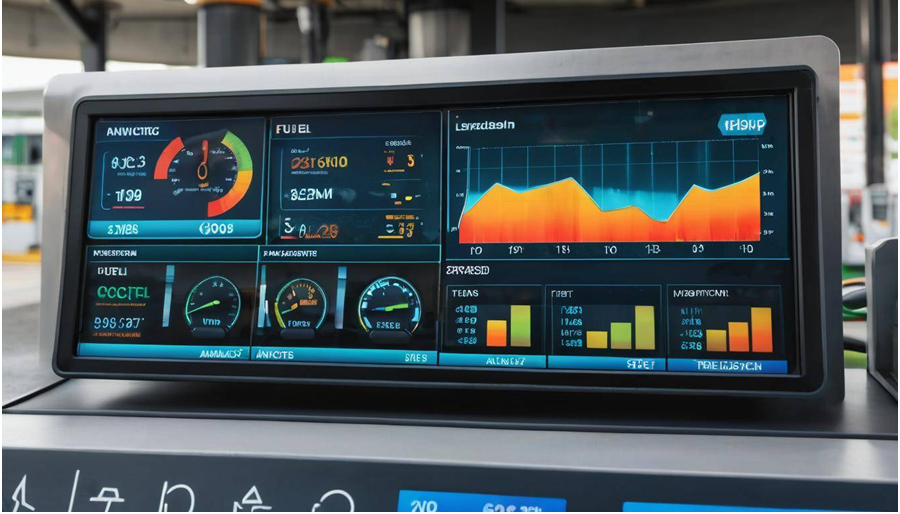Monitoring Fuel Transactions involves tracking and managing fuel usage across a fleet to optimize costs, enhance accuracy, and identify inefficiencies. This process is crucial for fleet managers as it enables better financial planning through insights on fuel economy, cost analysis, and can significantly reduce unnecessary expenditures related to fuel management.
Navigating the complexities of fleet management often feels like striking a delicate balance between cost control and operational efficiency. Monitoring fuel transactions goes beyond merely checking receipts; it revolves around developing a strategic advantage by mitigating unnecessary expenses and enhancing productivity. Establishing an efficient system begins with selecting appropriate hardware and software tailored to your specific needs.
Implementing these tools is crucial but requires thorough analysis of your existing practices to ensure a seamless transition. Engaging technologies designed for integrated tracking provides real-time insights into your operations, dramatically reducing unauthorized consumption and streamlining reporting processes. The result? A setup that not only saves costs but offers clarity and actionable data—a crucial trend acknowledged by over 60% of fleet managers striving for excellence in their operations.

Implementation of a Fuel Monitoring System
Implementing a fuel monitoring system through a fleet fuel card provider is a transformative step towards managing your fleet’s efficiency and extending its longevity. As you embark on this journey, the first crucial action is assessing your fleet needs. This means taking a close look at factors like the number and types of vehicles you operate, as well as evaluating current fuel consumption rates and patterns. Notably, existing fuel management practices must also be examined to identify any gaps or opportunities for enhancement. By truly understanding what you need, you set a solid foundation for selecting the most suitable technology later on.
Following your assessment, the next logical step is to choose the right technology that fits those identified needs.
Step I – Assessing Your Fleet Needs
- Number and types of vehicles in your fleet: Knowing what you have enables tailored solutions.
- Current fuel consumption rates and patterns: Identify where fuel is being used efficiently and where it isn’t.
- Existing fuel management practices: Acknowledge what systems are currently in place to identify strengths and weaknesses.
- Desired outcomes such as cost savings or efficiency improvements: Be specific about what success looks like for your operation.
After completing this needs assessment, it’s essential to choose the appropriate technology. Opting for fuel cards that integrate smoothly with an advanced fleet management system can significantly enhance operational efficiency.
Such systems should not operate in isolation; seamless data integration allows for real-time insights and informed decision-making.
Step II – Choosing the Technology
When selecting your technology, prioritize solutions that support automatic importing of transactions and robust reporting features. For instance, Fleetio and WEX Inc. are among the firms providing sophisticated systems designed to work effectively with fuel cards. These platforms streamline data gathering so that fleet managers can access critical metrics without labor-intensive manual entry.
However, adopting new technology is only half the battle; effective training is pivotal to ensure all team members maximize these tools’ potential.
Transitioning into the phase of training and implementation sets up your team for optimal performance.
Step III – Training and Implementation
Adequate training for drivers and fleet managers goes hand-in-hand with technology adoption for success. A well-structured training program will cover everything from correctly using fuel cards to efficiently managing digital receipts, making operations smoother and more accountable. Reports from businesses like AmeriGas hint that adequately trained staff can leverage these new systems with up to 20% more efficiency, proving that investment in human capital is just as important as investing in tools.
Implementing a thorough fuel monitoring system isn’t merely about installing software or hardware; it encompasses a holistic approach—one that balances meticulous planning with education and ongoing engagement from every member of the fleet management team.
With these foundational steps firmly in place, we can now explore how to streamline the comprehensive process of tracking transactions more effectively.
Monitoring and Tracking Fuel Transactions
Real-time monitoring and tracking fuel transactions through integrated fleet management software is a game-changer for many operations. It streamlines processes that were once cumbersome and prone to errors, transforming them into automated systems that work efficiently behind the scenes. For fleet managers, this means having access to critical data at their fingertips, allowing for immediate decision-making and better oversight of assets.
A compelling statistic comes from FleetNews, which found that over 60% of fleet managers experience significant reductions in unauthorized fuel consumption due to real-time tracking. This reduces the potential for fraud and makes it easier to identify discrepancies in records that could signal improper activities. Each feature listed in the table plays a crucial role in maintaining a well-oiled machine. For instance, real-time alerts allow fleet managers to respond promptly to suspicious activity. Imagine receiving an instant notification when a fuel purchase at an out-of-area station occurs—this immediacy can prevent costly losses before they escalate.
Additionally, automated data logging simplifies record-keeping. In the past, manual entry of fuel transactions could lead to numerous mistakes; incorrect figures or misplaced receipts were all too common. With automation, reports on fuel usage are generated seamlessly, allowing fleet managers to focus on higher-level strategic decisions rather than spending hours reconciling numbers.
Furthermore, GPS integration strengthens monitoring efforts by linking route planning with actual fuel consumption data.
This capability is crucial because it offers insights into fuel efficiency relative to specific routes taken by drivers. Are there consistent discrepancies between what’s expected based on the route and what was actually consumed? Assessing patterns like these can indicate areas needing improvement—whether that’s optimizing specific routes or identifying training opportunities for drivers to enhance their fuel efficiency.
Effective monitoring and tracking of fuel transactions using advanced software solutions can lead to improved operational efficiency and considerable cost savings in managing a fleet. Rather than simply reacting to problems as they arise, fleet managers are empowered to take proactive measures that safeguard against theft, minimize waste, and optimize resource allocation effectively.
As we continue, we’ll explore essential techniques that enhance data management and drive insightful analysis for better decision-making in fleet operations.
Data Management and Analysis Techniques
Effective data management and analysis can pinpoint inconsistencies and opportunities for savings. One essential strategy is centralized data collection. Centralizing all fuel transaction data in one platform simplifies the process of analyzing and reporting information. It eliminates confusion that often arises from juggling multiple sources of data. When everything is accessible in one place, it becomes much easier to spot discrepancies or trends that might otherwise go unnoticed. Many fleet managers nowadays opt for cloud solutions like Fleetio due to their accessibility from anywhere and ability to scale as their needs grow.
Beyond just collecting data, the tools you use to analyze this information can dramatically influence your operational efficiency.
This brings us to data analytics tools, which are indispensable in modern fleet management. Tools like Power BI or Tableau allow users to create visual dashboards that distill complex datasets into understandable formats. Imagine being able to see at a glance how much fuel each vehicle consumes compared to others or identifying surges in fuel usage during specific routes. These visual representations help fleet managers dive deep into patterns, anomalies, and trends in fuel consumption, facilitating quick decision-making.
As we embrace these methods, we begin to open up new avenues for discovering cost-saving opportunities.
One innovative approach is integrating predictive analytics into your operations. Predictive analytics uses historical data combined with machine learning techniques to forecast future fuel consumption patterns based on various factors such as route optimization, driving behavior, and even external variables such as weather conditions. By utilizing predictive analytics, fleet managers can proactively address potential inefficiencies before they become costly problems.
Actionable Tips for Implementation
- Begin by defining key performance indicators (KPIs) related to fuel usage.
- Always ensure your data inputs are clean and organized; consistency here will yield more accurate outputs.
- Utilize real-time monitoring systems that alert you when consumption exceeds predefined thresholds.
- Periodically reassess your analytics tools to ensure they meet the evolving needs of your operations.
The importance of careful data management cannot be overstated. By centering your efforts around robust collection methods and advanced analysis tools, you’re enhancing your reporting accuracy while setting the stage for ongoing improvements in decision-making and cost efficiencies within fleet operations.
As these approaches unfold, the impact on overall operational effectiveness becomes clearer, paving the way for even broader advancements in managing resources efficiently.
Business Efficiency and Cost Savings
Fuel is a significant expense in fleet management, typically accounting for 30% or more of overall operational costs. This reality underscores the vital role that effective monitoring systems can play. When fleet managers implement robust fuel transaction monitoring solutions, they gain oversight on spending and unlock opportunities for substantial savings. According to the American Transportation Research Institute, businesses leveraging these detailed tracking systems can achieve reductions in fuel costs of up to 15%.
Imagine a logistics company that spends several thousand dollars a month just on fuel alone: reducing those expenses by 15% can equate to thousands saved annually. Consider XYZ Logistics, which reported a staggering reduction of $5,000 monthly in fuel expenses after employing a comprehensive tracking strategy. This isn’t just saving pennies; it’s a game changer for their budget and bottom line.
To amplify these savings, managers should prioritize regular reporting and thorough reviews of their fuel data. By analyzing trends and patterns in fuel usage—such as identifying routes where fuel consumption spikes or flagging unusual transaction charges—managers can make informed adjustments to enhance efficiency further.
Integrating these monitoring systems requires a mindset shift towards data-driven decision-making. With real-time reporting capabilities, fleet managers are empowered to react to inefficiencies swiftly rather than waiting until monthly evaluations reveal a pattern that could have been addressed sooner. This proactive approach fosters an agile operation responsive to fluctuating market conditions.
As we continue exploring how these systems benefit operations, it becomes evident that the interplay between effective monitoring and holistic management enhances overall fleet performance.


